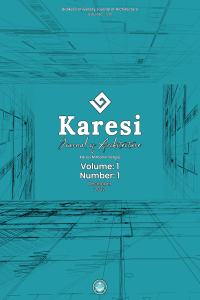Mimaride Trombe Duvarı Uygulamasının Enerji Analizi
Enerji Analizi, Güneş Enerjisi, Isı Transferi, Trombe Duvarı
Energy Analysis of the Trombe Wall Application in Architecture
Energy Analysis, Solar Energy, Heat Transfer, Trombe Wall,
___
- Abed, A.A, Ahmed, O.K., Weis, M.M, Ahmed, A.K. and Ali, Z.H. (2021). Influence of glass cover on the characteristics of PV/trombe Wall with BI-fluid cooling. Case Studies in Thermal Engineering. 27, 101273. https://doi.org/10.1016/j.csite.2021.101273.
- Abdeen, A., Serageldin, A.A., Ibrahim, M.G.E., El-Zafarany, A., Ookawara, S. and Murata, R. (2019). Experimental, analytical, and numerical investigation into the feasibility of integrating a passive Trombe wall into a single room. Applied Thermal Engineering. 154, 751-768. https://doi.org/10.1016/j.applthermaleng.2019.03.090.
- Abergel, T. and Delmastro, C., Is cooling the future of heating? 13 December 2020 https://www.iea.org/commentaries/is-cooling-the-future-of-heating, Erişim Tarihi: 08.04.2023.
- Abdullah, A.A., Atallah, F.S., Ahmed, O. K. and Alguburi, S. (2022). Effect of dusty weather on the performance of the PV/Trombe wall: Experimental assessment. Case Studies in Thermal Engineering. 39, 102419. https://doi.org/10.1016/j.csite.2022.102419.
- Agurto, L., Allacker, K., Fissore, A., Agurto, C. and De Troyer, F. (2020). Design and experimental study of a low-cost prefab Trombe Wall to improve indoor temperatures in social housing in the Biobio region in Chile. Solar Energy. 198, 704-721. https://doi.org/10.1016/j.solener.2020.02.003.
- Ahmed, O.K., Hamada, K.I. and Salih, A.M. (2019). Enhancement of the performance of Photovoltaic/Trombe wall system using the porous medium: Experimental and theoretical study. Energy. 171, 14-26. https://doi.org/10.1016/j.energy.2019.01.001.
- Bergman, T.L., Lavine, A.S., Incropera, F.P. and Dewitt, D.P. (2015). Isı ve Kütle Geçişinin Temelleri. Palme Yayıncılık.
- Bevilacqua, P., Benevento, F., Brunu, R. and Arcuri, N. (2019). Are Trombe wall suitable passive systems for the reduction of the yearly building energy requirements? Energy. 185, 554-566. https://doi.org/10.1016/j.energy.2019.07.003.
- Bojic, M., Johannes, K. and Kuznik, F. (2014). Optimizing energy and environmental performance of passive Trombe Wall. Energy and Buildings. 70, 279-286. https://doi.org/10.1016/j.enbuild.2013.11.062.
- Charqui, Z., El Moutaouakil, L., Boukendil, M., Hidki, R., Zrikem, Z. and Abdelbaki, A. (2023). Numerical simulation of turbulent coupled heat transfer in a Trombe wall subjected to periodic thermal excitations. Energy and Buildings. 278, 112631. https://doi.org/10.1016/j.enbuild.2022.112631.
- Dimassi, N. and Dehmani, L. (2016). Experimental heat flux analysis of a solar wall design in Tunisia. Journal of Building Engineering. 8, 70–80. https://doi.org/10.1016/j.jobe.2016.10.001.
- Duan, S., Jing, C. and Zhao, Z. (2016). Energy and exergy analysis of different Trombe walls. Energy and Buildings. 126, 517–523. https://doi.org/10.1016/j.enbuild.2016.04.052.
- Duffie, J.A., Beckman, W.A. and Blair, N. (2020). Solar Engineering of Thermal Processes, Photovoltaics and Wind. 5nd edition. John Wiley and Sons, 905s.
- ETKB, Enerji ve Tabii Kaynaklar Bakanlığı Türkiye Ulusal Enerji Planı. (2022). https://enerji.gov.tr/Media/Dizin/EIGM/tr/Raporlar/TUEP/T%C3%BCrkiye_Ulusal_Enerji_Plan%C4%B1.pdf, Erişim Tarihi: 08.04.2023
- Eurostat. (2022). Energy consumption in households. https://ec.europa.eu/eurostat/statistics-explained/index.php?title=Energy_consumption_in_households#Energy_consumption_in_households_by_type_of_end-use, Erişim Tarihi: 27 Mart 2023.
- Guyot, G., Walker, I., Sherman, M., Linares,P., Ortega, S.G. and Caillou, S. (2019). A review of performance-based approaches to residential smart ventilation, International Energy Agency’s Energy in Buildings and Communities Programme, Ventilation Information Paper no 39, March 2019. https://www.aivc.org/ Erişim Tarihi: 27 Mart 2023.
- Hu, Z., He, W., Ji, J. and Zhang, S. (2017). A review on the application of Trombe wall system in buildings, Renewable and Sustainable Energy Reviews, 70, 976-987. https://doi.org/10.1016/j.rser.2016.12.003.
- Ibrahim, A.K., Algburi,S. and Ahmed, O.K. (2023). Enhancement of the performance of the PV Trombe Wall: A short review, Cleaner Engineering and Technology, 14, 100652. https:/doi.org/10.1016/j.clet.2023.100652.
- Jaber, S. and Ajib, S. (2011). Optimum design of Trombe wall system in mediterranean region. Solar Energy. 85, 1891-1898. https://doi.org/10.1016/j.solener.2011.04.025.
- Jie, J., Hua, Y., Gang, P., Bin, J. and Hei, H. (2007). Study of PV-Trombe wall assisted with DC fan. Building and Environment. 42, 3529–3539. https://doi.org/10.1016/j.buildenv.2006.10.038.
- Mokni, A., Lashin, A., Ammar, M. and Mhiri, H. (2022). Thermal analysis of a Trombe wall in various climatic conditions: An experimental study. Solar Energy. 243, 247-263. https://doi.org/10.1016/j.solener.2022.08.011.
- Olenets, M., Piotrowski, J.Z. and Stroy, A. (2015). Heat transfer and air movement in the ventilated air gap of passive solar heating systems with regulation of the heat supply. Energy and Buildings. 103, 198–205. https://doi.org/10.1016/j.enbuild.2015.05.051.
- Piotrowski, J.Z., Stroy, A. and Olenets, M. (2013) Mathematical modelling of the steady state heat transfer processes in the convectional elements of passive solar heating systems. Archives of civil and mechanical engineering. 13, 394-400. https://doi.org/10.1016/j.acme.2013.02.002.
- Rabani, M. (2022). Experimental comparison of energy and exergy analysis of a new designed and a Normal Trombe Wall. Energy. 260, 125050. https://doi.org/10.1016/j.energy.2022.125050.
- Sa, A.C.B., Martins, A., Boaventura-Cunha, J., Lanzinha, J.C. and Paiva, A. (2017). An analytical approach to assess the influence of the massive wall material, thickness and ventilation system on the Trombe wall thermal performance. Journal of Building Physics. March, 1–24. https://doi.org/10.1177/1744259117697389.
- Shoubi, M. V., Masoud Shoubi, V., Bagchi, A. and Barough, A.Z. (2015). Reducing the operational energy demand in buildings using building information modeling tools and sustainability approaches. Ain Shams Engineering Journal. 6, 41-55. https://doi.org/10.1016/j.asej.2014.09.006.
- Yaman, M. (2021). Different Façade Types and Building Integration in Energy Efficient Building Design Strategies, International Journal of Built Environment and Sustainability. Published by Penerbit UTM Press. Universiti Teknologi Malaysia. IJBES 8(2)/2021, 49-61.
- Yılmaz, R., Kırtepe, E. ve Özbalta, N. (2018) Trombe duvarı ısıl performansının parametrik araştırılması. Uluslararası Katılımlı Anadolu Enerji Sempozyumu. Cilt 1, 354-363,18-20 Nisan 2018, Edirne.
- Başlangıç: 2022
- Yayıncı: Balıkesir Üniversitesi
Dilara DİNDAR, Yiğit YARDIMCI, Filiz ŞENKAL SEZER
Fosfojipsin Yapı Malzemesi Olarak Kullanım Olanaklarının Araştırılması
Kentlerde Sosyal ve Mekânsal Ayrışmanın Resim Sanatına Etkileri
Doğrama Özellikleri ve Açılış Biçimlerinin Yalın Camın Akustik Performansına Etkisi
Gülçin Gülsüm KONUK TAŞTAN, Işıl İPLİK, Şensin YAĞMUR
